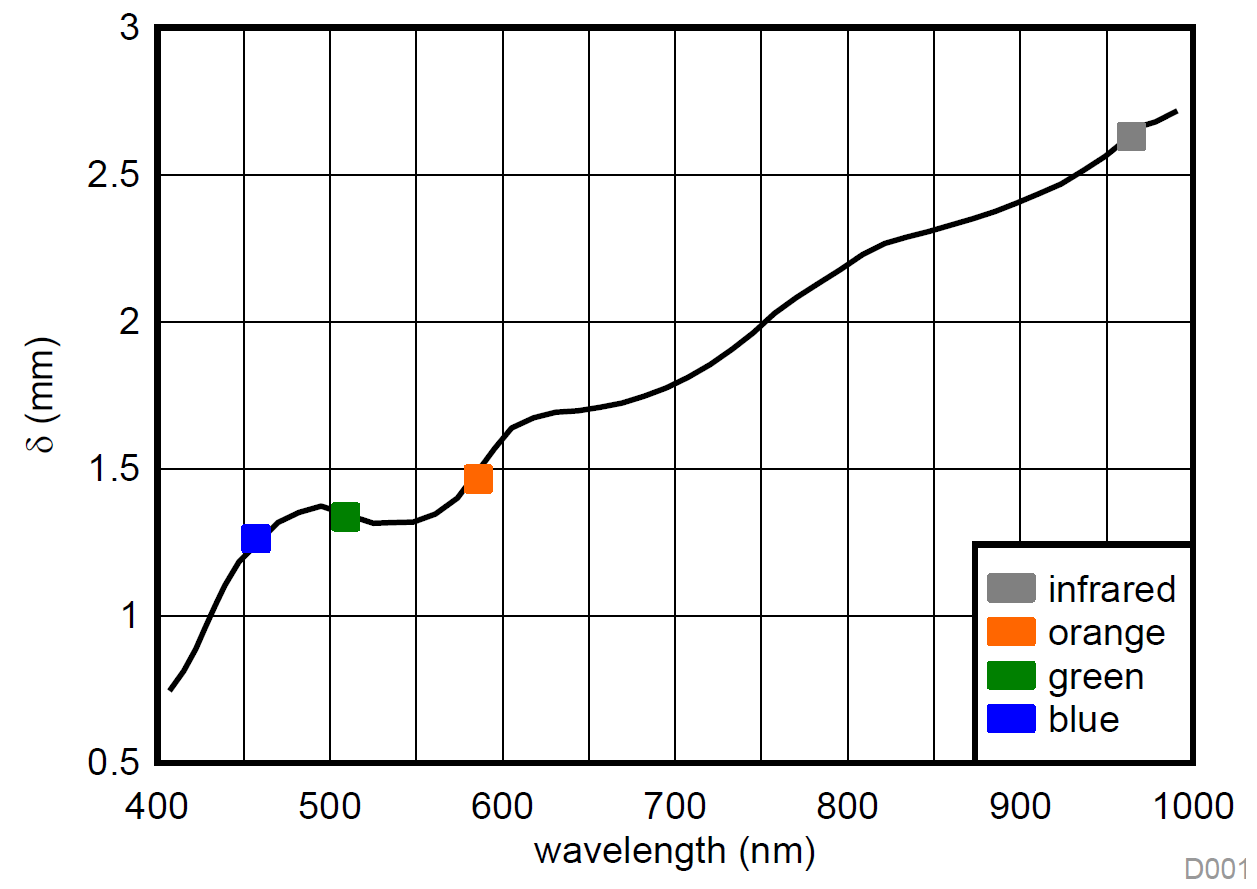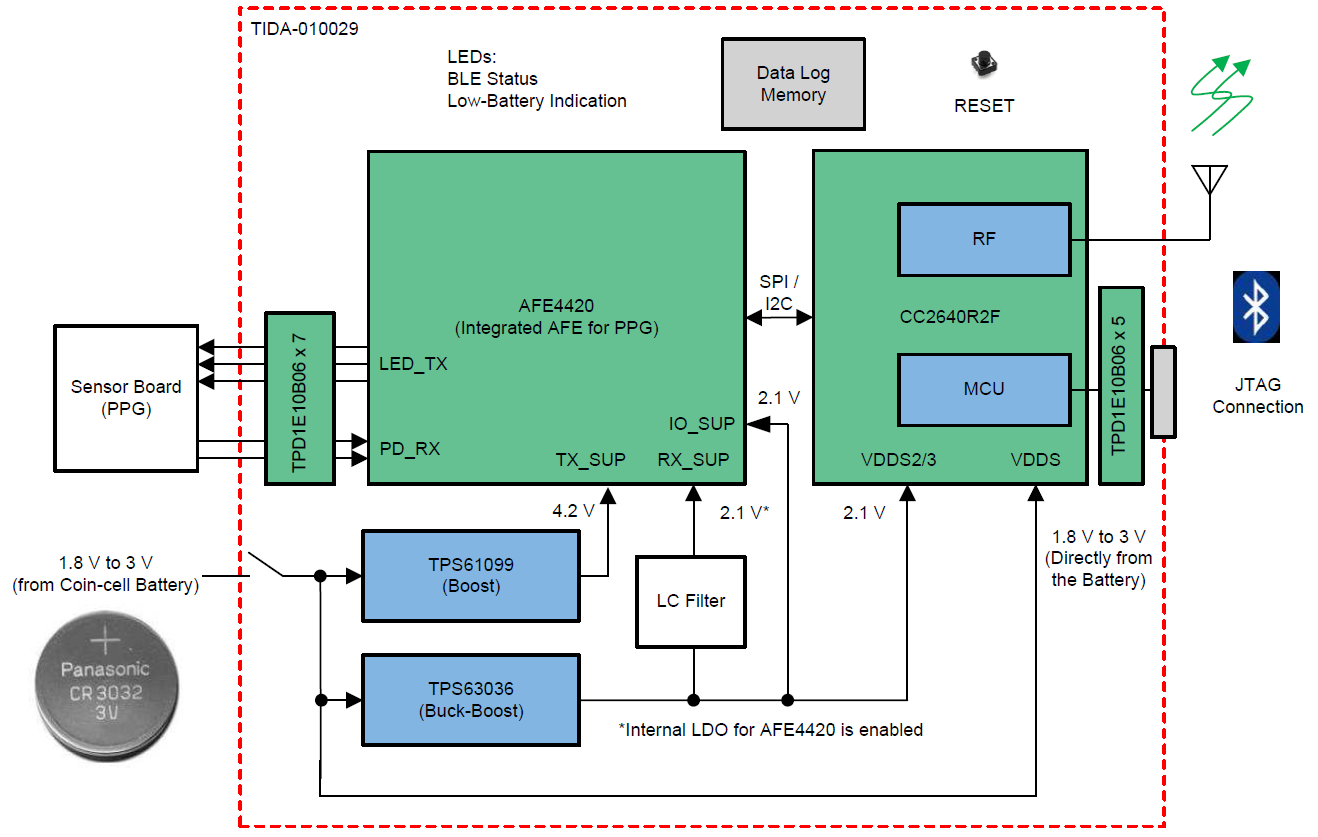SSZT538 february 2019 AFE4420 , CC2640R2F
Photoplethysmography (PPG) is a popular optical technology for heart rate monitors (HRMs) and peripheral capillary oxygen saturation (SpO2) measurements. It is simple and convenient because it requires only the attachment of an LED and a photodetector (PD) to the body.
The fundamental theory of PPG is based on the variation of light absorption across human tissue, which correlates to a change in the relative concentrations of oxyhemoglobin and deoxyhemoglobin. The change of blood volume due to the heart’s systole and diastole can be used to estimate arterial oxygen saturation.
| Go beyond traditional parameter measurement | |
| Learn more in our latest reference design, Multi-wavelength optical HRM and SpO2 monitoring reference design with Bluetooth® 5." | |
PPG signals are susceptible to motion artifacts depending on the wavelength of the light source. The light absorption and therefore the penetration depth into the tissue depend on the wavelength. The absorption of longer wavelengths such as red and near infrared (NIR) is relatively low, enabling deeper tissue penetration. Shorter wavelengths of light, such as green and blue, are strongly absorbed by melanin; thus, the penetration depth into tissue is relatively shallow. So red and NIR light PPG is subject to artifacts, while green and blue light PPG is relatively free from artifacts.
Figure 1 shows the skin-penetration depths of light signals with wavelengths from 400 to 1,000 nm.
 Figure 1 Optical Penetration Depth (Δ)
Shown for a Range of Light Sources of Different Wavelengths
Figure 1 Optical Penetration Depth (Δ)
Shown for a Range of Light Sources of Different WavelengthsUsing multiple LEDs and PDs in a multiplexed configuration achieves multiwavelength measurements and monitoring. Each diode and detector can support different wavelengths and also be used in a multiplexed fashion (in different sampling phases) to monitor different parameters.
The Multiwavelength optical HRM and SpO2 monitoring reference design with Bluetooth® 5 uses the AFE4420 single-chip bio-sensing front end, which simultaneously supports four LEDs and four time-multiplexed photodetector inputs. It integrates flexible LED drivers with complete receiver chains for the photodetectors.
The signal acquisition can be done in up to 16 phases, with the flexibility of allocation of LEDs and PDs in each phase (see Figure 2). It communicates with the CC2640R2F SimpleLink™ Bluetooth low energy wireless microcontroller (MCU), which has an integrated Arm® Cortex®-M3 and 2.4-GHz radio-frequency (RF) transceiver over Serial Peripheral Interface or I2C. The design supports wired data capture using a Joint Test Action Group connection as well as wireless data capture by sending it over Bluetooth 5.
 Figure 2 Multiwavelength Optical HRM
and SpO2 Monitoring Reference Design Block Diagram
Figure 2 Multiwavelength Optical HRM
and SpO2 Monitoring Reference Design Block DiagramThe key features of the design include:
- Raw PPG data for calculating heart rate, SpO2 and other related parameters. The AFE4420 is distinctive in the market with its level of integration, low power and size, and offers flexibility with ultra-low-power modes and integrated first-in-first-out, which can keep the MCU in sleep mode to increase battery life.
- Wireless connectivity using the CC2640R2F. The CC264R2F integrated Arm Cortex-M3 plus 2.4-GHz RF transceiver supports Bluetooth 4.2 and 5.0 profiles and is also used as a host processor. The internal DC/DC converter helps improve overall system efficiency and extend battery life. The built-in low-battery detection algorithm helps reduce external components in wearable applications.
- Low-power operation with a coin-cell battery. The design uses a single 3-V, 500-mA CR3032 coin-cell battery and is tested to give 100 hours of continuous operation and a battery life of 30 days for every one second per minute of transmission.
The reference design was created for medical, personal health care and fitness applications and comes with a design guide, schematic, layout and bill-of-materials files to help you quickly evaluate and accelerate product development. It facilitates real-time monitoring and data-logging capabilities and supports optimization for different configurations.
Additional Resources
- Check out these blog posts:
- Download our latest Analog Design Journal article, "Improving battery life in wearable patient monitors and medical patches."